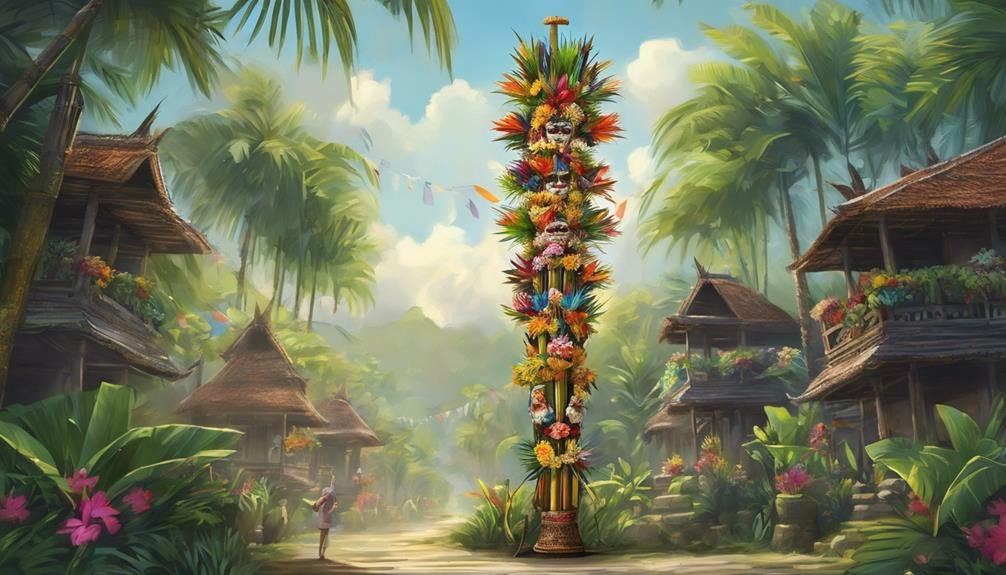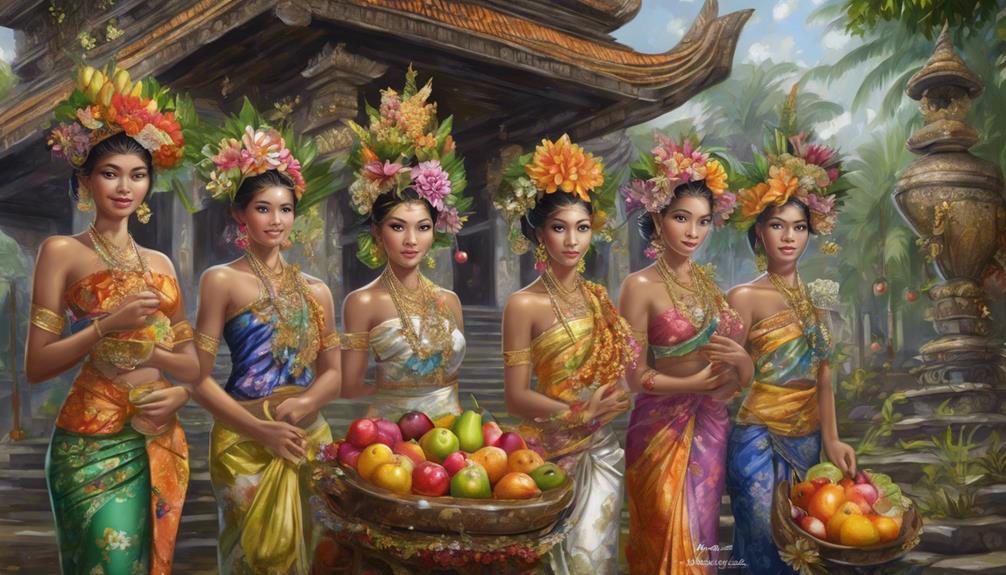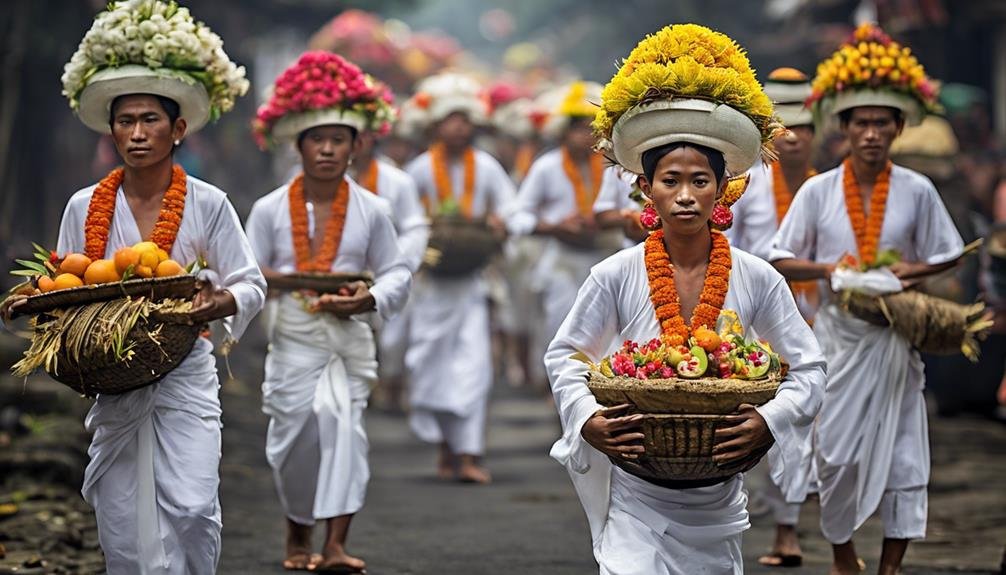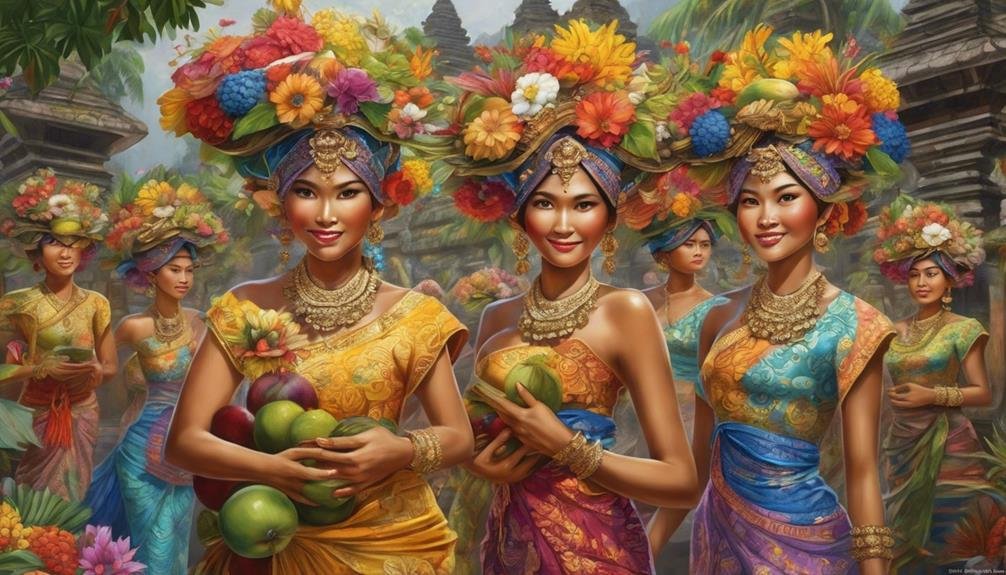Experience the vibrant Galungan celebration in Indonesia, where the victory of good over evil is honored through intricate offerings and colorful decorations. Explore the deep spiritual connections symbolized by the Penjor decorations, representing the cosmic balance between righteousness and malevolence. Witness special ceremonies that pay tribute to ancestors, underscoring the emphasis on familial respect and ties. Discover how this festival blends festive traditions with profound spiritual meanings, creating a culturally rich and spiritually resonant event that showcases the unique heritage and beliefs of the Balinese people. Uncover the enduring traditions and symbolism that make Galungan a truly special celebration.
Key Takeaways
- Attire gathering in temples signifies deep spiritual connection.
- Elaborate Penjor decorations symbolize cosmic balance.
- Special ceremonies honor ancestors, emphasizing familial ties.
- Festive traditions intertwine with spiritual significance.
- Galungan celebration is culturally rich and spiritually profound.
Significance of Galungan
Galungan holds deep cultural and spiritual significance in Indonesia, symbolizing the victory of good over evil and the return of ancestors' spirits. During this time, the Balinese people focus on achieving inner peace by managing their desires that disrupt harmony in life. The belief that ancestral spirits return home during Galungan underscores the importance of prayers and offerings to honor and welcome them back. This period serves as a reminder to reflect on one's actions and thoughts, aiming to maintain a sense of tranquility and balance within oneself.
Moreover, the historical roots of Galungan date back to Saka 804 or 882 AD, highlighting its enduring cultural importance in Indonesia. King Sri Jayakasunu's pivotal role in preserving and reinstating the celebration further emphasizes the deep-rooted tradition that Galungan represents. By acknowledging the significance of this festival, individuals can draw inspiration from the symbolic triumph of good over evil and work towards fostering inner peace in their lives.
Traditional Rituals and Offerings
As you explore the traditional rituals and offerings of Galungan in Indonesia, you'll notice the deep meaning and symbolism infused in every aspect of the ceremonies. Offerings made to ancestors signify a gesture of respect and gratitude, while the intricate decorations and elaborate ceremonies serve to enhance the spiritual connections maintained during this festive occasion.
Comparatively, the blend of prayers, feasting, and cultural performances creates a vibrant mosaic of tradition and celebration unique to Galungan.
Ritual Meaning and Symbolism
Emphasizing spiritual reverence and gratitude, the traditional rituals of Galungan in Indonesia intricately weave together symbolic offerings and ceremonial practices. During Galungan, the Balinese Hindus engage in a symbolic battle between good and evil, signifying the eternal struggle for inner harmony and righteousness. The rituals serve as a form of spiritual purification, aiming to cleanse the soul and seek blessings for the community. Through intricate ceremonies and prayers, devotees express their gratitude to the deities and ancestors for their guidance and protection. The traditional offerings of fruits, flowers, incense, and 'canang sari' symbolize the sincerity of the worshippers' hearts and their devotion to the divine beings. Below is a table highlighting the key aspects of the ritual meaning and symbolism in Galungan:
| Aspect | Description | Purpose |
|---|---|---|
| Symbolic Battle | Represents the eternal struggle between good and evil | Signifies the victory of righteousness |
| Spiritual Purification | Aims to cleanse the soul and seek blessings | Enhances inner harmony and spiritual protection |
| Offerings | Include fruits, flowers, incense, and 'canang sari' | Symbolize gratitude and devotion |
Offerings to Ancestors
The practice of making offerings to ancestors during Galungan in Indonesia serves as a significant way to honor and connect with the spirits of the deceased. Ancestral offerings, such as fruits, rice, flowers, and incense, are meticulously prepared and placed on family shrines or 'sanggah' to pay respect to the ancestors.
These offerings, known as 'sesajen' and 'banten', hold symbolic meanings related to prosperity, health, and protection, reflecting the Balinese belief in the spiritual connection between the living and the deceased. Lighting incense during ceremonies serves a dual purpose of purifying the environment and attracting the spirits of the ancestors.
Through these rituals, families express gratitude and maintain a profound connection with their lineage.
Decorations and Ceremonies
During Galungan in Indonesia, the elaborate decorations and ceremonial rituals play a pivotal role in honoring ancestral spirits and deities. Cultural traditions are vividly showcased through the intricate Penjor decorations that symbolize Mount Agung, adorning the streets of Bali during this festive period.
Offerings of 'banten' and 'sesaji' are meticulously prepared and presented as a gesture of reverence to the spiritual entities. Ceremonies such as 'mecaru' for purification and 'ngelawang' to ward off negative spirits are integral parts of the Galungan celebrations.
Women don traditional attire like 'kebaya' and 'udeng,' adding to the visual splendor of the festivities. The 'sesajen' offerings comprising fruits, flowers, rice cakes, and incense are arranged with utmost care and devotion, reflecting the deep-rooted cultural significance of these rituals.
Penjor Decorations
As you explore Penjor Decorations during Galungan, consider how these tall bamboo poles symbolize the majestic Mount Agung, embodying a profound connection to Balinese spirituality.
The intricate craftsmanship displayed in creating these structures showcases a blend of artistic flair and cultural reverence, serving as proof to the Balinese artisans' skill and devotion.
In contrast to other festive decorations, penjors stand out for their unique representation of the delicate balance between positive and negative energies, offering a deeper insight into the Balinese worldview.
Symbolism of Penjor
Symbolizing the sacred Mount Agung, Penjor decorations stand tall with curved bamboo poles embellished with coconut leaves, fruits, and flowers, embodying a profound connection to nature and spirituality during Galungan in Indonesia.
- The elegant curves of the bamboo represent the balance between the positive and negative forces in the universe.
- The coconut leaves symbolize purity and strength in the face of challenges.
- Fruits adorning the penjor signify prosperity and abundance in life.
- Flowers, with their vibrant colors and fragrances, evoke a sense of beauty and grace, enhancing the spiritual ambiance of the celebration.
Through these intricate details, the Penjor decorations not only beautify the surroundings but also carry deep cultural symbolism and spiritual significance, enriching the Galungan festivities with their profound meanings.
Making Penjor Structures
The intricate process of crafting Penjor structures involves skillfully weaving together bamboo poles and adorning them with symbolic offerings, showcasing the Balinese dedication to tradition and artistry before the vibrant celebrations of Galungan and Kuningan.
The bamboo craftsmanship displayed in constructing these tall poles reflects cultural pride and reverence for Balinese heritage. As families engage in creating these decorative masterpieces, a spirit of community competition emerges, with each household endeavoring to outdo the other in terms of creativity and intricacy.
This artistic expression not only beautifies the streets but also fosters a sense of unity and collaboration among neighbors. The Penjor structures stand as a confirmation of the Balinese people's commitment to preserving their customs and infusing every celebration with beauty and meaning.
Balinese Calendar Observance

Balinese calendar observance showcases a rich mosaic of cultural traditions interwoven with spiritual significance. During Galungan and Kuningan, Balinese communities engage in various rituals and practices that deepen their connection to their roots and beliefs. Here are four key aspects of Balinese calendar observance:
- Colorful Offerings: Vibrant offerings of fruits, flowers, and incense are meticulously arranged at temples and family compounds, symbolizing gratitude and devotion.
- Traditional Dances: Intricate dances like the Baris and Kecak performances captivate spectators with their graceful movements and rhythmic storytelling.
- Sacred Ceremonies: Elaborate ceremonies conducted by priests, such as the 'Piodalan' temple anniversary celebrations, honor deities and ancestors.
- Community Unity: The Balinese calendar observance fosters a strong sense of community spirit, as families come together to participate in rituals and share blessings.
Through these practices, Balinese traditions aren't only preserved but also passed down through generations, reinforcing the spiritual fabric of the island's culture.
Good Vs. Evil Symbolism
As you explore the symbolism of good versus evil in Galungan, consider the intricate representation of a cosmic battle between Dharma and Adharma. Balinese mythological characters embody these forces, showcasing the eternal struggle between righteousness and malevolence.
The elaborate rituals and offerings during Galungan serve as a poignant reminder of the importance of upholding spiritual integrity and resisting negative influences.
Symbolic Battle Representation
Symbolizing the eternal struggle between good and evil in Balinese culture, Galungan embodies the triumph of righteousness over wrongdoings. During this celebration, the symbolic battle representation manifests in various ways:
- Colorful Penjor poles line the streets, symbolizing the victory of good over evil.
- Offerings are meticulously prepared and presented to honor the divine forces of good.
- Communities come together in prayer and unity, showcasing resilience in the face of adversity.
- Traditional dances and performances depict the cosmic battle between Dharma and Adharma, highlighting the eternal struggle for balance.
Through these symbolic representations, Galungan reinforces the importance of unity and determination in upholding moral values amidst life's challenges.
Balinese Mythological Characters
In the world of Balinese mythology, the eternal struggle between good and evil finds its embodiment in characters like Dewa Indra and Mayadenawa. Dewa Indra symbolizes good, righteousness, and virtue, while Mayadenawa represents evil, wickedness, and deceit.
Their mythical clash during Galungan reflects the moral symbolism of the triumph of good over evil. Dewa Indra's victory over Mayadenawa signifies the victory of righteousness and justice.
These mythological characters aren't merely figures in mythological lore but serve as moral guides for the Balinese people, teaching important lessons about the consequences of one's actions.
Understanding the roles of Dewa Indra and Mayadenawa is essential for grasping the symbolic significance of Galungan and the broader cultural and spiritual values they represent.
Divine Deity Honoring

During Galungan in Indonesia, honoring divine deities like Sang Hyang Widhi is a meticulous and revered practice that involves intricate offerings and prayers. The rituals are essential in showing respect and devotion to the gods.
Here are some key elements that contribute to the rich tradition of divine deity honoring during Galungan:
- Divine Offerings: Elaborate offerings of fruits, flowers, incense, and traditional Balinese cakes are meticulously prepared and presented as a symbol of gratitude and reverence.
- Sacred Ceremonies: Special ceremonies dedicated to Dewa Bhatara and other revered deities in the Hindu pantheon are conducted with utmost solemnity and devotion.
- Penjor Decorations: Placing Penjor decorations along roadsides is a common practice during Galungan, signifying the community's respect for the divine entities.
- Traditional Customs: The precise methods and sequences followed in honoring the deities during the Galungan celebrations reflect the deep-rooted traditions and beliefs of the Indonesian Hindu community.
These practices showcase the diverse ways in which divine deity honoring is carried out, highlighting the unique cultural identities between Javanese and Balinese traditions.
Galungan Cultural Identity
The cultural significance of Galungan for the Balinese people is deeply ingrained in their traditions and serves as a focal point for expressing their heritage and beliefs. Galungan isn't just a mere celebration; it's a symbol of the eternal battle between good and evil in the Balinese belief system. The elaborate offering ceremonies during Galungan are a way for the Balinese to show gratitude to their deities and ancestors, reinforcing their spiritual beliefs and connection to the divine.
Through the cultural traditions and rituals of Galungan, the Balinese showcase their deep-rooted cultural practices that have been passed down through generations. It's during Galungan that the Balinese community comes together to honor their shared heritage, strengthening their cultural identity. This celebration isn't merely a festive occasion but a time when the Balinese people reflect on their values and beliefs, highlighting the integral role that Galungan plays in preserving and celebrating their cultural heritage with traditional fervor.
Victory Celebration

Symbolizing triumph over adversity, Galungan is a victory celebration that holds deep cultural significance for the Balinese people. This festival encapsulates the essence of victory symbolism and cultural importance, resonating with the Balinese community at a profound level.
During Galungan, the streets come alive with vibrant colors, intricate decorations, and the sweet aroma of incense, creating a visually stunning atmosphere. The jubilant sounds of traditional music and dance fill the air, adding to the festive spirit that permeates the island.
As families come together to pray and make offerings, a sense of spiritual harmony and inner peace envelops the community, fostering a collective sense of unity and connection to the divine. The Balinese people's reverence for their ancestors and the traditions passed down through generations is palpable during this time, underscoring the enduring cultural legacy that Galungan represents.
Eternal Struggle Representation
Representing the eternal struggle between good and evil, Galungan in Indonesia emphasizes the triumph of righteousness over wrongdoing. This portrayal of the eternal battle serves as a symbolic reminder of the constant spiritual conflict individuals face in their lives. The essence of Galungan lies in the belief that spiritual devotion and adherence to moral principles are essential in overcoming adversities and challenges. Through the rituals and practices observed during this celebration, individuals are encouraged to reflect on their inner strength and commitment to upholding Dharma, the cosmic order.
The Balinese people's deep-rooted connection to Galungan showcases how their cultural identity is intertwined with the values of inner harmony and spiritual strength. The significance of this festival goes beyond mere festivities; it serves as a poignant representation of the eternal struggle between light and darkness. By commemorating Galungan, individuals are reminded of the importance of unity in spiritual forces, leading to clarity of mind and righteous actions.
Religious Commemoration

Emphasizing the essence of spiritual devotion and cultural identity, Galungan in Indonesia serves as a profound religious commemoration. During this time, the streets come alive with vibrant colors and lively sounds as the community comes together to celebrate this sacred occasion.
Here are a few aspects that contribute to the richness of this religious event:
- Festive traditions: The air is filled with the aroma of incense and the sound of traditional music, creating a joyous atmosphere that permeates the entire island.
- Spiritual significance: People clad in traditional attire gather in temples to offer prayers and make offerings, symbolizing their deep spiritual connection to the divine.
- Penjor decorations: Elaborate bamboo poles adorned with young coconut leaves and other decorations line the streets, symbolizing the cosmic mountain and the balance between good and evil.
- Ancestor veneration: Special ceremonies are held to honor ancestors, reinforcing the importance of familial ties and respect for those who came before.
Galungan truly encapsulates the intertwining of festive traditions and spiritual significance in a celebration that's both culturally rich and spiritually profound.
Frequently Asked Questions
Which Months Are in Galungan 2024?
In 2024, Galungan falls in June and December. These months are significant for Galungan festivities as they symbolize the triumph of good over evil. During this time, Balinese Hindus engage in rituals, make offerings, and decorate with penjor.
On What Day Is Hari Raya Galungan Celebrated?
On Hari Raya Galungan, celebrated to honor the victory of good over evil, traditional rituals like prayers and offerings are observed. The celebration date varies, falling on different days in the Balinese calendar.
What Is Meant by Galungan?
Galungan, a Hindu celebration, holds deep meaning and significance. It symbolizes the triumph of good over evil. During this time, traditions include offering prayers and decorations to honor deities, fostering a sense of spiritual connection.
Where Is Galungan Celebrated?
Galungan is celebrated in various locations across Indonesia, showcasing its cultural significance. The festivities bring communities together, offering a unique blend of tradition and modernity. It's a time of joy, reflection, and honoring ancestors.
Conclusion
To sum up, Galungan in Indonesia is a significant cultural and religious celebration that embodies the eternal struggle between good and evil. The traditional rituals, offerings, penjor decorations, and observance of the Balinese calendar all contribute to the unique identity of this festival.
It serves as a victory celebration, a representation of the eternal struggle, and a commemoration of religious beliefs. Galungan truly showcases the rich cultural heritage and spiritual beliefs of the Balinese people.


